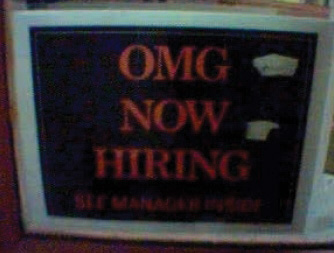
Source: Photo courtesy of Ralph Aichinger, http://www.flickr.com/photos/sooperkuh/3275153928/.
In her blog Love This, MJ (full name not provided) relates that she’s been an aspiring clothes designer since she started sewing tops for her Barbie dolls. Things weren’t going well, though, as she tries to break into the industry. One thing she notices is that there aren’t a lot of female fashion designers out there—Vera Wang, Betsey Johnson, and a few more. Not many. So she starts trying to figure it out with questions like these:
Four standard filters for job applicants are
Which of these might be used to winnow out applications for a job as a clothes designer? Explain in ethical terms.

Source: Photo courtesy of Geoff Stearns, http://www.flickr.com/photos/tensafefrogs/1523795/.
The University of Charleston is a private, nonreligious institution with a very particular job opening: the Herchiel and Elizabeth Sims “In God We Trust” Chair in Ethics. According to the job description, the successful candidate for this job as a professor “must embrace a belief in God and present moral and ethical values from a God-centered perspective.”Rob Capriccioso, “Divinely Inspired Bias?,” Higher Ed, March 1, 2006, accessed May 24, 2011, http://www.insidehighered.com/news/2006/03/01/charleston.
According to Erwin Chemerinsky, a law professor at Duke University, “The description that ‘candidates must embrace a belief in God and present moral and ethical values from a God-centered perspective,’ violates the Civil Rights Act as religious discrimination in employment.”Rob Capriccioso, “Divinely Inspired Bias?,” Higher Ed, March 1, 2006, accessed May 24, 2011, http://www.insidehighered.com/news/2006/03/01/charleston. Imagine you’re in charge of every step of the process of filling this job. How could you respond in terms of
You’re the university president. The person who currently holds the In God We Trust Professorship has, by all accounts, been doing a mediocre to poor (but not directly unacceptable) job. One day you happen to trip across the person’s blog page and notice that your professor claims to be a sadist and practices a mild form of devil worship (also, the prof’s favorite movie is The Omen). Right now the In God We Trust Professor of ethics is down the hall lecturing to seventy-five undergrads. You sneak to the door and listen from outside. The professor sounds just like always: dull and passionless, but the talk is about the Bible, and nothing’s being said that seems out of line with the job description. Still, you decide to terminate the relationship.

Source: Photo courtesy of katkimchee, http://www.flickr.com/photos/midwestkimchee/206762729/.
The New York Times reports that there’s a “huge difference between sixteen and nineteen years old,” when you’re talking about prospects for professional baseball. A kid whose skills knock your socks off for a sixteen-year-old just looks modestly good when he practices with nineteen-year-olds.Michael S. Schmidt and Alan Schwarz, “Baseball’s Use of DNA Raises Questions,” New York Times, July 21, 2009, accessed May 24, 2011, http://www.nytimes.com/2009/07/22/sports/baseball/22dna.html?hp.
This is a significant problem in the Dominican Republic, which produces excellent baseball players but little in the way of reliable paperwork proving who people really are and when they were born. The Cleveland Indians learned all about that when they gave a $575,000 bonus to a seventeen-year-old Dominican named Jose Ozoria, only to later find out he was actually a twenty-year-old named Wally Bryan.
This and similar cases of misidentification explain why baseball teams are starting to apply genetic tests to the prospects they’re scouting. Typically, the player is invited to provide a DNA sample from himself and his parents to confirm that he’s no older than he claims. The player pays for the test and is reimbursed if the results show he was telling the truth.
Many experts in genetics consider testing an unethical violation of personal privacy.
Assume you accept that testing a prospect’s age is a bona fide occupational qualification (after all, the job is to be a prospect: a developing player, not an adult one). Once you accept that, how do you draw the line? Couldn’t teams be tempted to use DNA facts for other purposes? The Times article interviews a coach who puts it this way:
I know [the baseball teams taking the DNA samples] are looking into trying to figure out susceptibility to injuries, things like that. If they come up with a test that shows someone’s connective tissue is at a high risk of not holding up, can that be used? I don’t know.Michael S. Schmidt and Alan Schwarz, “Baseball’s Use of DNA Raises Questions,” New York Times, July 21, 2009, accessed May 24, 2011, http://www.nytimes.com/2009/07/22/sports/baseball/22dna.html?hp.
Can you formulate an ethical argument in favor of teams secretly using DNA tests to do just that, check for as many yellow and red flags as possible in the young prospect’s genetic code?
You decide to do the test in question four. The problem is people aren’t trees; you can’t age them just by counting genetic rings—you also need to do some cross-testing with the parents’ DNA. You do that and run into a surprise: it turns out that the young prospect’s father who’s so proud of his athletic son isn’t the biological dad. Now what?

Source: Photo courtesy of Manuel Cernuda, http://www.flickr.com/photos/melkorcete/180238980/.
Goldman Sachs is an expansive financial services company. Many clients are institutional: private companies and government organizations wanting to raise cash seek Goldman’s help in packaging and then selling stock or bonds. On the other side, private investors—wealthy individuals wanting to multiply their riches—receive a hearty welcome at Goldman because they have the cash to purchase those stocks and bonds. Ultimately, Goldman Sachs is a hub where large companies, governmental powers, and wealthy people come and do business together.
Executives at Goldman Sachs are among the world’s highest paid. According to a New York Times article, “At the center of Goldman’s lucrative compensation program is the partnership. Goldman’s partners are its highest executives and its biggest stars. Yet while Goldman is required to report compensation for its top officers, it releases very little information about this broader group, remaining tightlipped about even basic information like who is currently a partner.”Susanne Craig and Eric Dash, “Study Points to Windfall for Goldman Partners,” New York Times, January 18, 2011, accessed May 24, 2011, http://dealbook.nytimes.com/2011/01/18/study-points-to-windfall-for-goldman-partners/?hp.
The rest of the article investigates this shadowy partnership. The conclusions: “Goldman has almost 860 current and former partners. In the last 12 years, they have cashed out more than $20 billion in Goldman shares and currently hold more than $10 billion in Goldman stock.”
This tally of accumulated wealth in Goldman stock doesn’t even include the standard salary and cash bonuses the partners receive, but leaving that aside, here’s the math: $30 billion divided by 860 divided by 12 should give some sense of the wealth each of these corporate stars is accumulating over the course of a year. To give a provisional idea of how large the number of dollars is here, when you try plugging $30 billion into an iPhone calculator, you find the screen can’t even hold a number that long. Using a different calculator yields this result: $2.9 million per partner every year.
The 2.9 million can be compared with the salary earned by the average American: $50,000 a year. The Goldman partner gets that in less than a week. This huge money explains the clawing fight that goes on inside Goldman to become a partner. The odds are long. Each time the books are opened to admit a new class, only 1 of 330 Goldman employees makes the cut. It is, in the words of one former partner, “a very Darwinian, survival-of-the-fittest firm.”
In the public comments section of the New York Times story about Goldman, a person identified as GHP picks up on the firm’s characterization as a “Darwinian, survival-of-the-fittest” place. He wrote, “The French revolution was also very Darwinian, let’s give that a try.” During the French Revolution, the wealthy and powerful were rewarded with a trip to the guillotine.
Probably, GHP isn’t just annoyed about how much money executives at Goldman make, he, like a lot of people, is peeved by the fact that the company was bailed out by the federal government during the 2008–9 financial crisis. Had the taxpayers (people making $50,000) not kicked in, Goldman might’ve gone bankrupt, and all that money its partners accumulated in stock would’ve vanished. As it happens, the US government’s bailout was masterminded by US Treasury Secretary Henry Paulson. His previous job was CEO (and partner) at Goldman.
Goldman is dominated by a “Darwinian, survival-of-the-fittest” mentality. What does that mean?
One contributor to the New York Times comments section writes, “There are sure to be lots of pointed, angry posts about how unfair it is that these guys make so much money etc. But if we are honest, there is a fair amount of envy and pure remorse that we weren’t bright enough to go down that path! And these guys are very bright.”
How could these comments be construed to explain why high wages and big bonuses are used by Goldman to motivate its workers? What is it that makes big money (or the possibility of big money) function as a powerful motivator to encourage employees to work hard and well? Ethically, how can this use of big money be justified?
One difference between offering an employee a wage increase and offering a bonus is that the latter doesn’t come automatically the next year. The employee has to earn it from scratch all over again.

Source: Photo courtesy of C.P. Storm, http://www.flickr.com/photos/cpstorm/140115572/.
A Washington Post story about firing employees relates that some companies use “the surgical method: terminations that last about 15 seconds, after which former employees are ushered off company property.”Eli Saslow, “The Art of Letting Employees Go,” Washington Post, August 9, 2009, accessed May 24, 2011, http://www.washingtonpost.com/wp-dyn/content/article/2009/08/08/AR2009080802659.html?hpid=topnews.
It doesn’t have to be that way, though. For about $2,000 per fired employee, the outplacement company Five O’Clock Club will help employers manage the actual termination moment more compassionately. Later on, the fired worker receives a year of career coaching to help get back on track.
What does the Five O’Clock Club recommend managers do at the critical moment when giving the bad news? To answer, according to the Post, they offer a booklet titled How to Terminate Employees While Respecting Human Dignity, which “asks managers to approach layoffs with the understanding that, ‘unlike facilities and equipment, humans have an intrinsic worth beyond their contribution to the organization.’”Eli Saslow, “The Art of Letting Employees Go,” Washington Post, August 9, 2009, accessed May 24, 2011, http://www.washingtonpost.com/wp-dyn/content/article/2009/08/08/AR2009080802659.html?hpid=topnews.
Then some catchphrases are provided for managers to use:
Five O’Clock Club vice president Kim Hall—who downs a lot of Tylenol and coffee on the job—relates several other phrases that may be helpful:
In sum, the Five O’Clock Club helps workers feel better when they’re fired, and helps them get on with their lives. Meanwhile, employers get a hedge against lawsuits. The outplacement service, according to the Five O’Clock Club literature, “can redirect anger or anxiety away from the organization and…encourage the newly-fired to sign their severance agreements so they can get on with their lives.”Eli Saslow, “The Art of Letting Employees Go,” Washington Post, August 9, 2009, accessed May 24, 2011, http://www.washingtonpost.com/wp-dyn/content/article/2009/08/08/AR2009080802659.html?hpid=topnews.
The Five O’Clock Club charges $2,000 per firing. If you were fired, would you prefer to receive the compassionate end the Five O’Clock Club provides, or just get shown the door but also get to keep that $2,000 for yourself?
According to the Five O’Clock Club, “Unlike facilities and equipment, humans have an intrinsic worth beyond their contribution to the organization.”
In general terms, here are three firing situations:
Looking at these three contexts and the Five O’Clock Club, do you think their services should be hired in all three situations? Do the ethics of firing change depending on why the person is being fired? Explain.
Recall some of the Five O’Clock Club’s prepacked firing sentences:
The contrasting method of firing employees—the surgical method—is to look the person in the eye, say you’re fired, and have security march the ex-employee out the door, all in less than a minute.